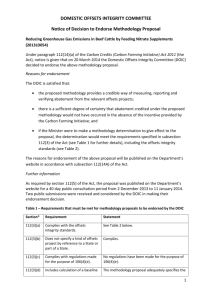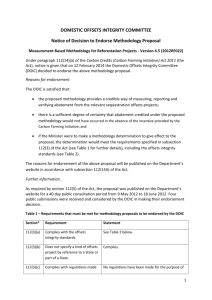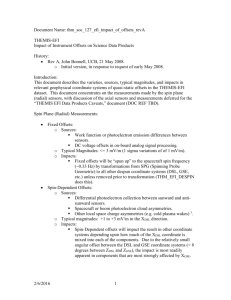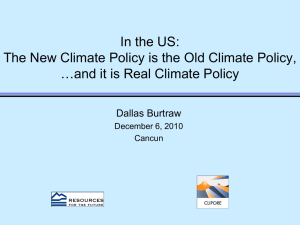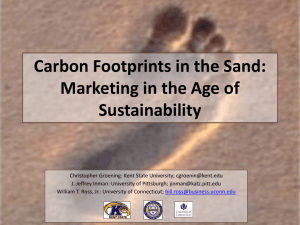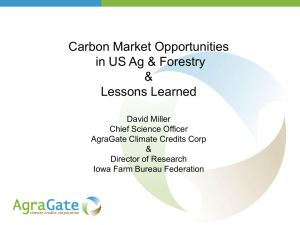SOUTH POLE CARBON ASSET MANAGEMENT Discussion Questions: Hunt Allcott
advertisement
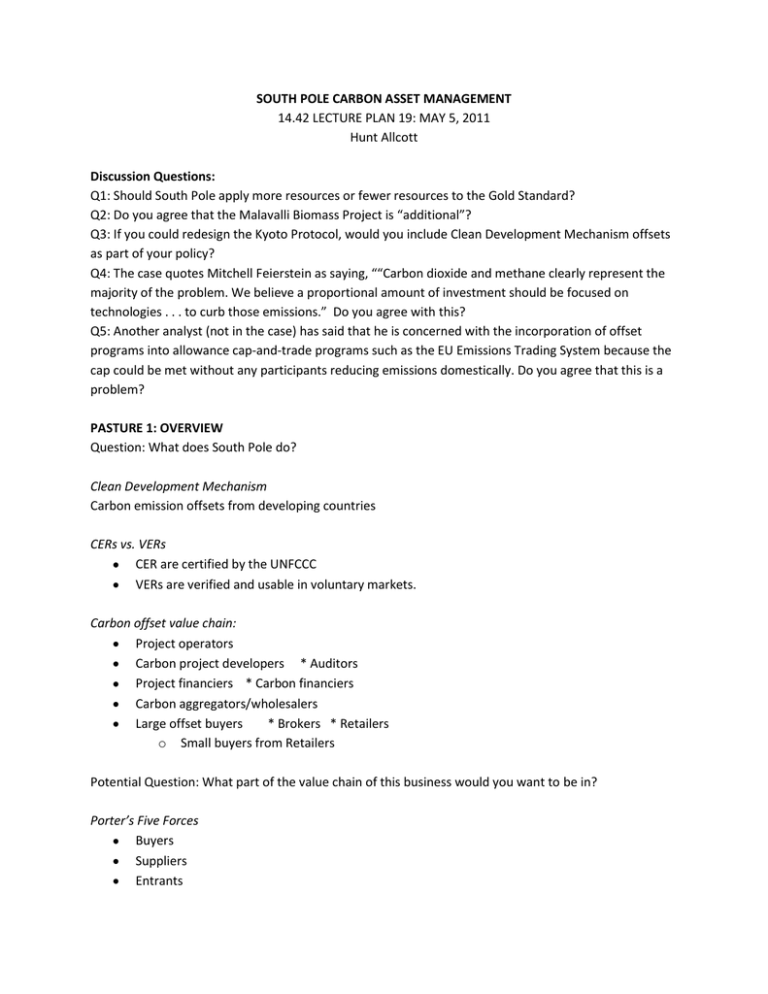
SOUTH POLE CARBON ASSET MANAGEMENT 14.42 LECTURE PLAN 19: MAY 5, 2011 Hunt Allcott Discussion Questions: Q1: Should South Pole apply more resources or fewer resources to the Gold Standard? Q2: Do you agree that the Malavalli Biomass Project is “additional”? Q3: If you could redesign the Kyoto Protocol, would you include Clean Development Mechanism offsets as part of your policy? Q4: The case quotes Mitchell Feierstein as saying, ““Carbon dioxide and methane clearly represent the majority of the problem. We believe a proportional amount of investment should be focused on technologies . . . to curb those emissions.” Do you agree with this? Q5: Another analyst (not in the case) has said that he is concerned with the incorporation of offset programs into allowance cap-and-trade programs such as the EU Emissions Trading System because the cap could be met without any participants reducing emissions domestically. Do you agree that this is a problem? PASTURE 1: OVERVIEW Question: What does South Pole do? Clean Development Mechanism Carbon emission offsets from developing countries CERs vs. VERs CER are certified by the UNFCCC VERs are verified and usable in voluntary markets. Carbon offset value chain: Project operators Carbon project developers * Auditors Project financiers * Carbon financiers Carbon aggregators/wholesalers Large offset buyers * Brokers * Retailers o Small buyers from Retailers Potential Question: What part of the value chain of this business would you want to be in? Porter’s Five Forces Buyers Suppliers Entrants Substitutes Rivals PASTURE 2: ADDITIONALITY Question: What do we mean by “additionality”? Two aspects: 1. Would the project have been built? 2. What is the difference between project and non-project (counterfactual) CO2 emissions? Would the project have been built? π=pY-c(Y)+zΔe Y=Electricity output z=Emission offset price Δe=Change in carbon emissions. Profitability constraint: π≥0 Additionality constraint: pY-c(Y)<0 What if input or output prices, production technology, or regulations change? You could have a project that is additional now, but not additional after the change. So it’s really “expected additionality.” But additionality is not revised as conditions change, even though these projects last 30 years! What is Δe? The CDM often assumes that ΔQ’=Y, i.e. the output of a project offsets production from a fossil facility one-for-one. o Draw S&D in output markets. When is this true? o When demand is perfectly inelastic or residual supply is perfectly elastic. o More of a problem? When demand is more elastic and residual supply is more inelastic. For natural gas projects, the CDM requires that input supply not be fully inelastic. Why? What if input supply is elastic, but not fully elastic? Question: Is Malavalli Biomass Project additional? Reasons why not: There are other biomass projects in India. What is the counterfactual? o One is that another power plant is built, which might have higher emissions. o But there are electricity shortages! So you might have no other power plants built, and thus lower electricity usage! So the CO2 emission reductions might be completely false. Question: How would you calculate a counterfactual for energy efficiency projects? Example: clean cookstoves Change in Emissions = Utilization hours per day * (New Emission Rate/hour – Old Emission Rate/hour) Include “rebound effect” or intensive margin elasticity? Include income effects? Takeaways: Demonstrating additionality is difficult Demonstrating a counterfactual is more difficult The CDM is trying its best, but it’s not perfect This is one reason why offsets are a problem. PASTURE 3: OFFSETS VS. ALLOWANCES Question: If you could redesign the Kyoto Protocol, would you include Clean Development Mechanism offsets as part of your policy? Reasons why Reasons why not Credits encourage developing countries not to pass laws that could reduce carbon emissions, because the credits must be additional to the laws. In China, this could be a problem, as they seem very willing to develop renewables Raynor quote on indulgences Steve Raynor (Oxford): “What these companies are allowing people to do is carry on with their current behavior with a clear conscience.” Question: Do you agree? At the very least, voluntary offsets generate emission abatement We also want the offsets to change people’s choices by imposing a cost of carbon. Do we think this is happening? I think not? Offsets could in fact be bad because they impose moral costs! Trotignon quote on ppt: no domestic reductions. Cost reduction But more uncertainty Draw graph: Incorporating Offsets into EU ETS Show welfare gain Question: Is it unfair that other countries are abating? o No – they are being paid to abate. They only do so if it is profitable. Question: But where is marginal benefit function? And what if we are relatively uncertain about the MCA curve in developing countries compared to MCA in developed countries? o Then you could be far off of the optimum. o EU countries limit offsets to about 13.5% of total allowances for just this reason Transactions costs Question: Are there transactions costs with offsets? From what? Auditors Country approval infrastructure CDM Executive Board approval infrastructure Question: What do transactions costs have to do with whether I prefer allowances vs. offsets? Dispersion of sources: If centralized (like fossil fuels) then we can regulate a limited set of sources. If dispersed (like garbage dumps or ag) then have to regulate many sources in an allowance program, but fewer with offsets. Draw graph: NT= Total number of sites NA = Number of abating sites or segments of sites to = Transaction cost per offset site ta= Transaction cost per allowance site to>ta total transaction cost for offsets: TOffsets = Transactions costs lower for offsets when: toNA<taNT Or: to/ta< NT/NA Question: What is the ratio of to to ta in a developing vs. developed country? In developing countries, there are no established regulatory institutions, so it’s hard regulate anyone, so ratio low - closer to 1. o Use David Victor example: “The Collapse of the Kyoto Protocol.” In developed countries, we already have a monitoring infrastructure, but audits and establishing counterfactuals is quite expensive, so ratio much larger than 1. But transactions costs also distort which projects are selected: Things that are difficult to show as additional. o E.g. energy efficiency: an increase in price of 10% should reduce demand by 10%. Large projects, instead of small. Move away from countries with bad infrastructure for doing the approvals. E.g. Africa, Asia. PASTURE 4: HFCs HFCs “Carbon dioxide and methane clearly represent the majority of the problem. We believe a proportional amount of investment should be focused on technologies . . . to curb those emissions.” -Mitchell Feierstein, Cheyne Capital Question: Do you agree with this? Yes: Low cost abatement – this is the market at work No: These projects are perhaps less likely to be additional – HFCs being phased out in developed countries anyway. PASTURE 5: VER AND CER PRICES Background: What determines CER/VER prices? Sell at an almost fixed discount to the EU allowance price. What determines the EU price? Information about supply and demand in EU Natural gas prices, temperatures (electricity demand) o Banking rules key in making these short run issues important Policy decisions Question: Where do we expect VER and CER prices to go? Question: What are the biggest risks? Policy risk. o What if no EU policy post-2012? o What if an international agreement fails to materialize? Economic growth o This would bolster voluntary markets, increase supply of pollution, and also increase the political will for an international agreement or many domestic agreements Takeaway: Policy risk. Much bigger in environmental business than elsewhere. PASTURE 6: GO FOR GOLD? What are the benefits of the Gold Standard? 1. Higher quality in voluntary markets 2. More assurance that they will be accepted in compliance markets. But product differentiation is only useful in voluntary markets. In compliance markets, just need to be above the bar. There are two ways of answering this question: 1. Do the same projects but not have stakeholder consultations and the other Gold Standard verification. 2. Do different projects that are lower-quality. Go for Gold: Economic growth could weaken regulation, which helps voluntary carbon markets Low marginal cost, and many clients willing to pay a premium – up to 50% price premium! VCS standard is insufficient, and not clear that South Pole has sufficient brand to differentiate without Gold Standard. Don’t go for Gold: Economic growth dampens demand in voluntary carbon markets because altruism is a superior good. A post-Kyoto treaty could have lower standards than the Gold Standard It is not zero marginal cost: stakeholder consultations. Make sure the class develops an opinion on the relative path of Gold Standard vs. non-Gold Standard credits. Have the class vote. MIT OpenCourseWare http://ocw.mit.edu 14.42 / 14.420 Environmental Policy and Economics Spring 2011 For information about citing these materials or our Terms of Use, visit: http://ocw.mit.edu/terms.

